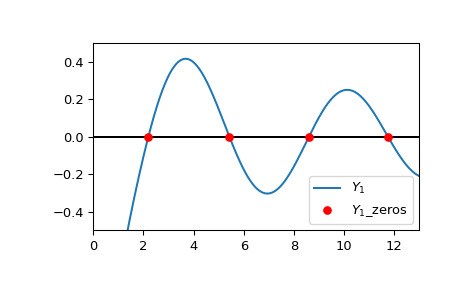本文简要介绍 python 语言中 scipy.special.y1_zeros 的用法。
用法:
scipy.special.y1_zeros(nt, complex=False)#计算贝塞尔函数 Y1(z) 的 nt 个零点,以及每个零点处的导数。
每个零 z1 处的导数由 Y1’(z1) = Y0(z1) 给出。
- nt: int
要返回的零数
- complex: 布尔值,默认为 False
设置为 False 仅返回实数零;设置为 True 仅返回具有负实部和正虚部的复数零。请注意,后者的复共轭也是函数的零,但此例程不返回。
- z1n: ndarray
Y1(z)的第n个零的位置
- y1pz1n: ndarray
第 n 个零的导数 Y1’(z1) 值
参数 ::
返回 ::
参考:
[1]张善杰和金建明。 “特殊函数的计算”,John Wiley and Sons,1996 年,第 5 章。https://people.sc.fsu.edu/~jburkardt/f77_src/special_functions/special_functions.html
例子:
计算 的前 4 个实根和根处的导数:
>>> import numpy as np >>> from scipy.special import y1_zeros >>> zeros, grads = y1_zeros(4) >>> with np.printoptions(precision=5): ... print(f"Roots: {zeros}") ... print(f"Gradients: {grads}") Roots: [ 2.19714+0.j 5.42968+0.j 8.59601+0.j 11.74915+0.j] Gradients: [ 0.52079+0.j -0.34032+0.j 0.27146+0.j -0.23246+0.j]提取实部:
>>> realzeros = zeros.real >>> realzeros array([ 2.19714133, 5.42968104, 8.59600587, 11.74915483])绘制 和前四个计算根。
>>> import matplotlib.pyplot as plt >>> from scipy.special import y1 >>> xmin = 0 >>> xmax = 13 >>> x = np.linspace(xmin, xmax, 500) >>> zeros, grads = y1_zeros(4) >>> fig, ax = plt.subplots() >>> ax.hlines(0, xmin, xmax, color='k') >>> ax.plot(x, y1(x), label=r'$Y_1$') >>> ax.scatter(zeros.real, np.zeros((4, )), s=30, c='r', ... label=r'$Y_1$_zeros', zorder=5) >>> ax.set_ylim(-0.5, 0.5) >>> ax.set_xlim(xmin, xmax) >>> plt.legend() >>> plt.show()
通过设置
complex=True计算 的前 4 个复数根和根处的导数:>>> y1_zeros(4, True) (array([ -0.50274327+0.78624371j, -3.83353519+0.56235654j, -7.01590368+0.55339305j, -10.17357383+0.55127339j]), array([-0.45952768+1.31710194j, 0.04830191-0.69251288j, -0.02012695+0.51864253j, 0.011614 -0.43203296j]))
相关用法
- Python SciPy special.y1用法及代码示例
- Python SciPy special.y1p_zeros用法及代码示例
- Python SciPy special.y0用法及代码示例
- Python SciPy special.ynp_zeros用法及代码示例
- Python SciPy special.yve用法及代码示例
- Python SciPy special.yvp用法及代码示例
- Python SciPy special.y0_zeros用法及代码示例
- Python SciPy special.yn用法及代码示例
- Python SciPy special.yv用法及代码示例
- Python SciPy special.yn_zeros用法及代码示例
- Python SciPy special.exp1用法及代码示例
- Python SciPy special.expn用法及代码示例
- Python SciPy special.ncfdtri用法及代码示例
- Python SciPy special.gamma用法及代码示例
- Python SciPy special.ellip_harm_2用法及代码示例
- Python SciPy special.i1e用法及代码示例
- Python SciPy special.smirnovi用法及代码示例
- Python SciPy special.ker用法及代码示例
- Python SciPy special.k0e用法及代码示例
- Python SciPy special.j1用法及代码示例
- Python SciPy special.logsumexp用法及代码示例
- Python SciPy special.expit用法及代码示例
- Python SciPy special.polygamma用法及代码示例
- Python SciPy special.nbdtrik用法及代码示例
- Python SciPy special.nbdtrin用法及代码示例
注:本文由纯净天空筛选整理自scipy.org大神的英文原创作品 scipy.special.y1_zeros。非经特殊声明,原始代码版权归原作者所有,本译文未经允许或授权,请勿转载或复制。
